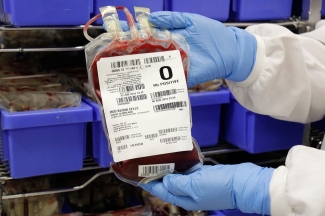Updated resource for health-care professionals: massive hemorrhage and emergency transfusion
Tuesday, October 05, 2021 Tricia Abe
The latest evidence on managing patients with massive hemorrhage, a major cause of potentially preventable deaths, is now available in a recently updated chapter of Canadian Blood Services’ Clinical Guide to Transfusion. According to Dr. Gwen Clarke, associate medical director of laboratory services at Canadian Blood Services and co-editor of the Guide, the chapter on massive hemorrhage and emergency transfusion is a valuable resource for staff in hospital emergency departments, operating rooms and obstetrical services as well as medical, surgical and laboratory trainees.
The management of patients with massive hemorrhage, such as the severely injured trauma patient or bleeding obstetrical patient, has changed dramatically over the past 10 years. Dr. Jacqueline Trudeau, anesthesiologist at Vancouver General Hospital and lead author of the updated chapter, says that the most significant change a hospital can make to manage these patients is to introduce a massive hemorrhage protocol (MHP). “The development and implementation of an MHP engages everyone on the clinical teams, standardizes transfusion best practice, and leads to better patient outcomes.”
Chapter 11, Massive Hemorrhage and Emergency Transfusion, is available on the Canadian Blood Services’ Professional Education Transfusion Medicine website, a resource hub for health-care professionals working in transfusion in Canada.
Canadian Blood Services – Driving world-class innovation
Through discovery, development and applied research, Canadian Blood Services drives world-class innovation in blood transfusion, cellular therapy and transplantation—bringing clarity and insight to an increasingly complex healthcare future. Our dedicated research team and extended network of partners engage in exploratory and applied research to create new knowledge, inform and enhance best practices, contribute to the development of new services and technologies, and build capacity through training and collaboration. Find out more about our research impact.
The opinions reflected in this post are those of the author and do not necessarily reflect the opinions of Canadian Blood Services nor do they reflect the views of Health Canada or any other funding agency.
Related blog posts
Canada’s leading experts in transfusion medicine came together to collaborate on Treat the Bleed, a website that provides guidance for front-line physicians in treating bleeding patients.
Part 2 in a six-part series by Dr. Jeannie Callum, a hospital-based transfusion specialist who shares her real-life experience witnessing the impact of blood donation on patient lives. Here she provides some fascinating insight into blood transfusion, past and present, and emphasizes the need for male donors and why some donors may be safer for patients.

